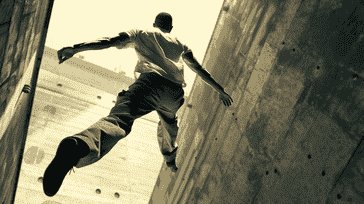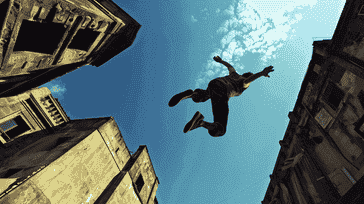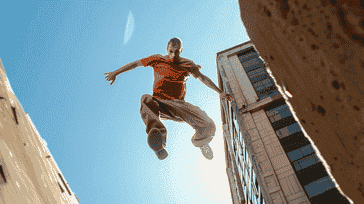
Parkour, also known as the art of movement, is a thrilling and physically demanding discipline that involves navigating through obstacles with speed, efficiency, and style. It originated in France in the late 1980s and has since gained popularity worldwide. As a practitioner of parkour myself, I have experienced the incredible benefits it offers, both physically and mentally. In this article, I will guide you through the history and evolution of parkour, explain the benefits of practicing this extreme sport, and delve into the various parkour techniques such as vaults, jumps, and precision landings.

Parkour traces its roots back to the 1980s in France, where a group of young men known as the Yamakasi pioneered this high-intensity movement. They sought to develop a unique approach to urban acrobatics, blending elements of gymnastics, martial arts, and street stunts. Over time, parkour evolved into a discipline that not only promotes physical fitness but also challenges practitioners to overcome mental barriers.
Engaging in parkour offers a myriad of benefits for individuals of all ages and fitness levels. Firstly, parkour is an excellent form of outdoor fitness that combines cardiovascular exercise, strength training, and flexibility. The dynamic movements involved help improve overall body coordination, agility, and balance. Additionally, parkour serves as an effective full-body workout that tones muscles and enhances endurance.
Moreover, parkour provides a unique outlet for self-expression and creativity. As you navigate through obstacles, youll develop problem-solving skills and learn to think on your feet. This mental aspect of parkour is equally important as the physical aspect, as it cultivates discipline, focus, and a strong sense of determination. Lastly, parkour fosters a strong sense of community, with practitioners supporting and encouraging each other to push their limits.

Vaults are fundamental techniques in parkour that allow practitioners to efficiently overcome obstacles such as walls, railings, and fences. There are various types of vaults, each with its own purpose and execution. One popular vault is the "kong vault," where the practitioner propels themselves forward, using their hands to clear the obstacle while maintaining momentum. The "dash vault" involves planting one hand on the obstacle and vaulting over it with the legs swinging through. Mastering these vaulting techniques requires practice, precision, and confidence.
Jumps are an integral part of parkour and are used to clear gaps, rooftops, and other large obstacles. The most basic jump in parkour is the "precision jump," where the practitioner leaps from one point to another with accuracy and control. The "cat leap" involves jumping from a lower surface to a higher one while maintaining momentum. Another advanced jump is the "wall run," where the practitioner sprints towards a wall, pushes off with their feet, and propels themselves upwards or sideways. Jumps require strength, balance, and the ability to judge distances accurately.

Precision landings are crucial in parkour to ensure a safe and controlled descent after jumps or drops. A proper landing technique absorbs the impact and protects the joints from injury. The "roll" is a common landing technique used in parkour, where the practitioner rolls over their shoulder to distribute the force of impact. Another landing technique is the "soft landing," where the practitioner lands with slightly bent knees and rolls the impact through the legs. Precision landings require body awareness, flexibility, and the ability to adapt to different surfaces.
As with any extreme sport, parkour carries a risk of injuries. However, by following safety guidelines and practicing proper technique, the risk can be minimized. Common injuries in parkour include sprained ankles, fractures, and wrist injuries. To prevent these injuries, it is essential to warm up before each training session, practice proper technique, and gradually progress to more advanced movements. Additionally, wearing appropriate protective gear such as padded gloves and ankle braces can provide added support and reduce the risk of injury.
To master parkour techniques and improve overall performance, consistent training is key. Begin by focusing on building a strong foundation of strength and flexibility. Incorporate exercises such as push-ups, pull-ups, squats, and lunges into your routine to strengthen the upper body, core, and lower body. Additionally, incorporate plyometric exercises like box jumps and depth jumps to improve explosive power. Consistent practice of parkour-specific movements such as vaults, jumps, and precision landings will help refine your technique and enhance your overall performance.
While parkour and free running are often used interchangeably, they do have distinct differences. Parkour focuses on efficiency, speed, and overcoming obstacles in the most direct way possible. It emphasizes functional movement and practical applications. Free running, on the other hand, places more emphasis on creative expression and acrobatic movements. It incorporates flips, spins, and other flashy maneuvers into the discipline. Both parkour and free running share the same foundation but diverge in their approach and style.
Parkour is a minimalist sport that requires little equipment. However, there are a few essential items to enhance safety and performance. Proper footwear is crucial, with specialized parkour shoes offering grip, flexibility, and protection. Additionally, wearing comfortable clothing that allows for freedom of movement is essential. Other optional gear includes gloves for added grip and protection, knee pads for cushioning during landings, and a backpack to carry water and other essentials during training sessions.
Safety should always be a top priority when practicing parkour. Start by choosing appropriate training locations with suitable obstacles and surfaces. Ensure that the area is clear of any hazards such as broken glass or sharp objects. Always warm up before each session and listen to your body to avoid overexertion. Progress gradually, mastering basic techniques before attempting more advanced movements. Finally, practice with a buddy or join a parkour community to receive guidance and support.
Over the years, numerous parkour athletes have gained recognition for their extraordinary skills and contributions to the discipline. Sébastien Foucan, one of the founders of parkour, is credited with popularizing the discipline beyond France. David Belle, another influential figure, played a significant role in popularizing parkour through his appearances in films. Other notable parkour athletes include Tim Shieff, a world champion freerunner, and Livewire, known for his impressive jumps and creative style. These athletes have not only pushed the boundaries of parkour but have also inspired countless others to take up the discipline.
Parkour communities and events provide a platform for practitioners to connect, learn, and showcase their skills. These communities offer a supportive environment where individuals can train together, share knowledge, and motivate each other. Many cities have parkour parks or designated training areas where practitioners can gather and train in a safe and controlled environment. Furthermore, parkour events such as competitions, workshops, and jams allow practitioners to come together and celebrate their passion for the discipline.
Parkour is an exhilarating and physically demanding discipline that offers numerous benefits for those seeking an adrenaline-fueled outdoor fitness experience. By mastering the techniques of vaults, jumps, and precision landings, practitioners can navigate through obstacles with speed, efficiency, and style. However, it is crucial to prioritize safety, practice proper technique, and gradually progress to more advanced movements. With dedication, perseverance, and the support of the parkour community, you can unlock your full potential in mastering the art of parkour.
CTA: Ready to embark on your parkour journey? Join a local parkour community or find a training facility near you to start honing your skills today! Remember, safety should always be your top priority, so be sure to practice with caution and seek guidance from experienced practitioners. Get ready to push your limits and experience the exhilaration of mastering parkour techniques!